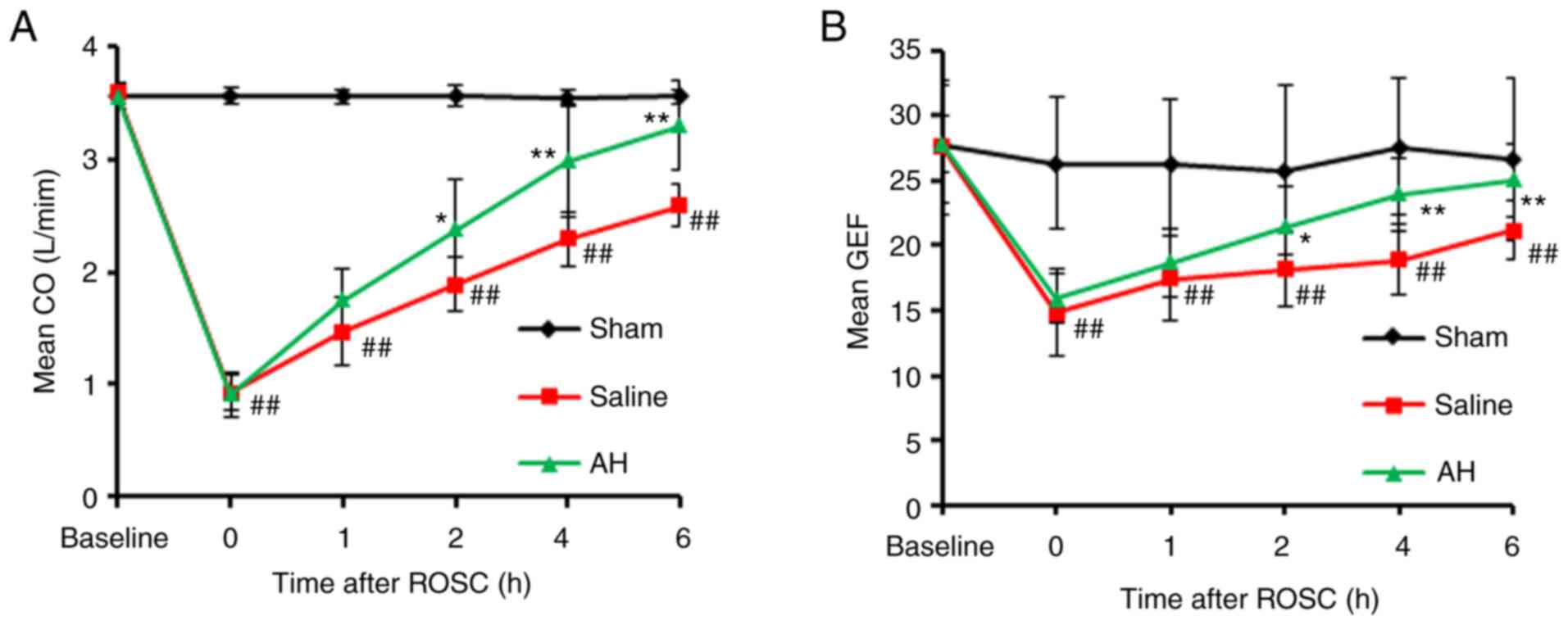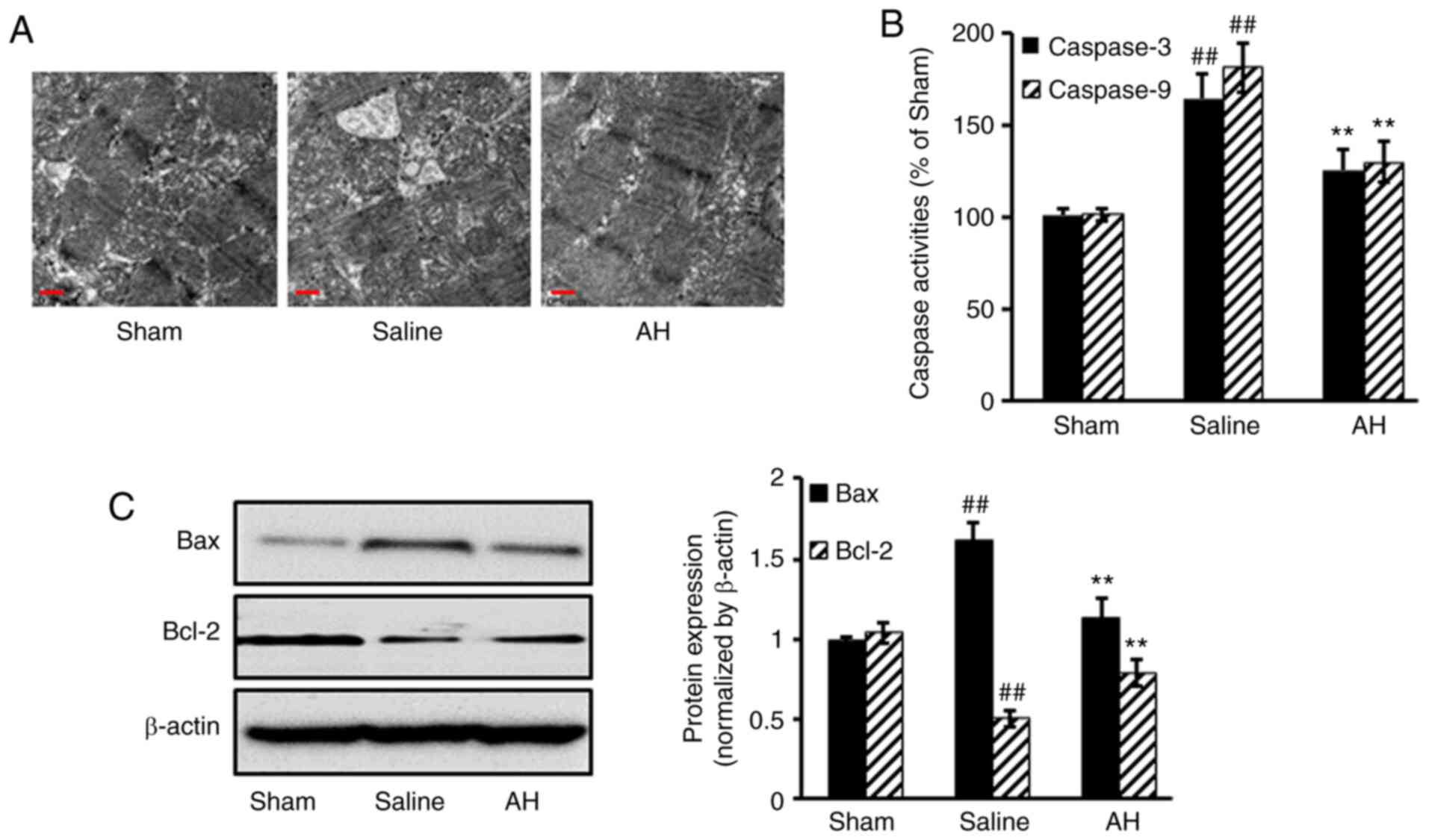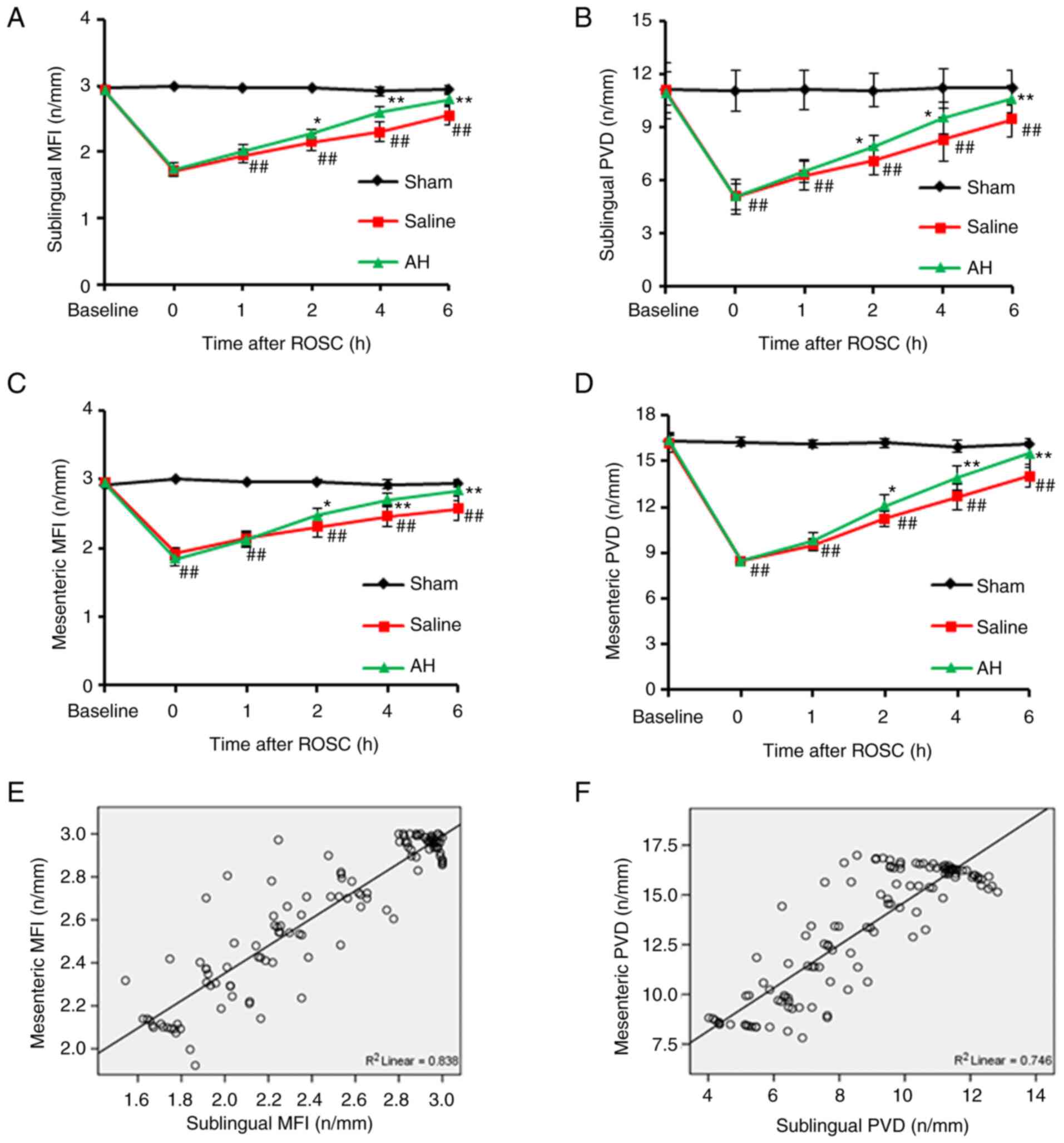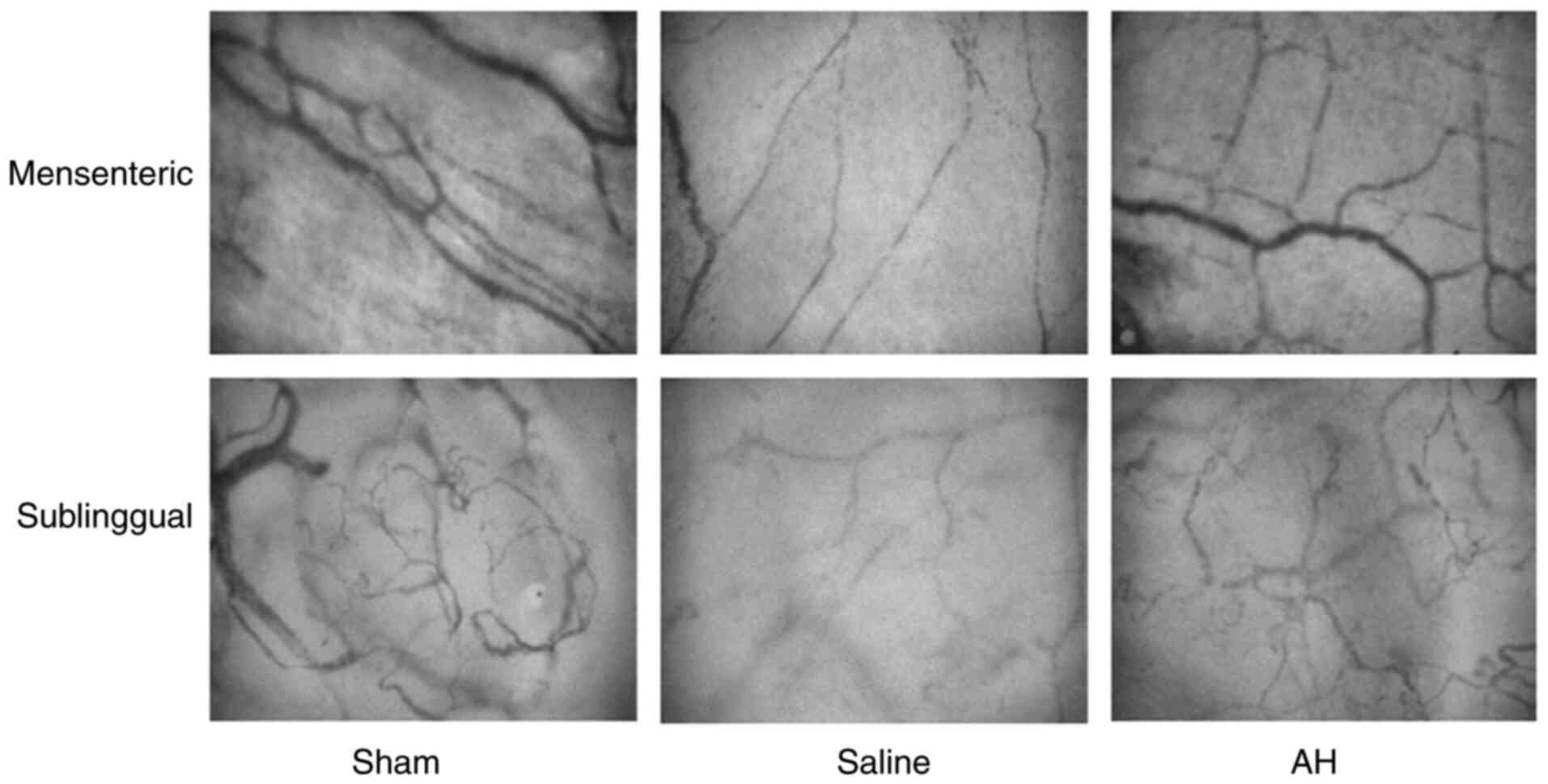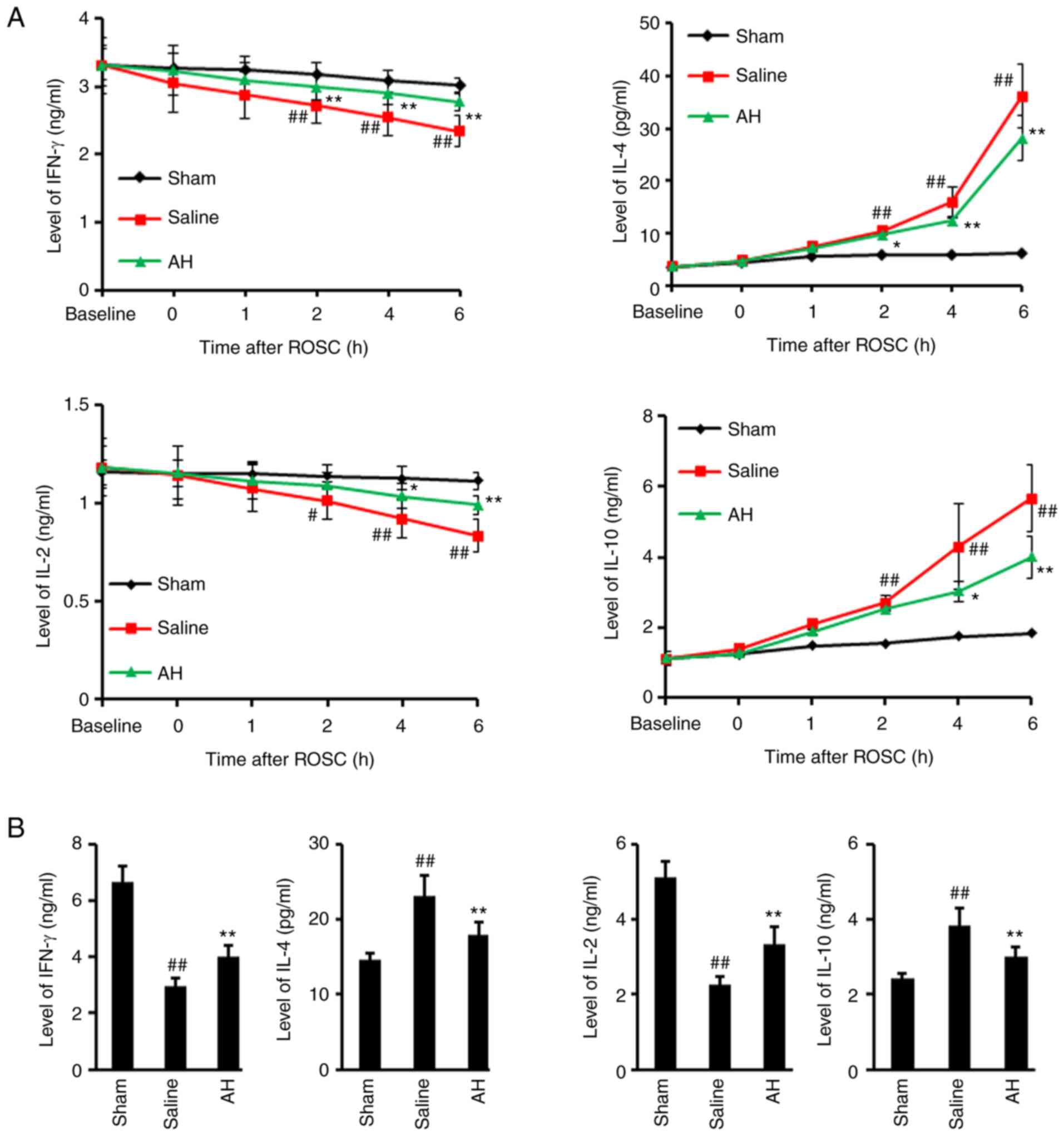|
1
|
Goldberger ZD, Chan PS, Berg RA, Kronick
SL, Cooke CR, Lu M, Banerjee M, Hayward RA, Krumholz HM and
Nallamothu BK: American Heart Association Get With The
Guidelines-Resuscitation (formerly National Registry of
Cardiopulmonary Resuscitation) Investigators. Duration CNCNof
resuscitation efforts and survival after in-hospital cardiac
arrest: An observational study. Lancet. 380:1473–1481.
2012.PubMed/NCBI View Article : Google Scholar
|
|
2
|
Neumar RW, Nolan JP, Adrie C, Aibiki M,
Berg RA, Böttiger BW, Callaway C, Clark RS, Geocadin RG, Jauch EC,
et al: Post-cardiac arrest syndrome: Epidemiology, pathophysiology,
treatment, and prognostication. A consensus statement from the
International Liaison Committee on Resuscitation (American Heart
Association, Australian and New Zealand Council on Resuscitation,
European Resuscitation Council, Heart and Stroke Foundation of
Canada, InterAmerican Heart Foundation, Resuscitation Council of
Asia, and the Resuscitation Council of Southern Africa); the
American Heart Association Emergency Cardiovascular Care Committee;
the Council on Cardiovascular Surgery and Anesthesia; the Council
on Cardiopulmonary, Perioperative, and Critical Care; the Council
on Clinical Cardiology; and the Stroke Council. Circulation.
118:2452–2483. 2008.PubMed/NCBI View Article : Google Scholar
|
|
3
|
Korth U, Krieter H, Denz C, Janke C,
Ellinger K, Bertsch T, Henn C and Klein J: Intestinal ischaemia
during cardiac arrest and resuscitation: Comparative analysis of
extracellular metabolites by microdialysis. Resuscitation.
58:209–217. 2003.PubMed/NCBI View Article : Google Scholar
|
|
4
|
Stallion A, Kou TD, Latifi SQ, Miller KA,
Dahms BB, Dudgeon DL and Levine AD: Ischemia/reperfusion: A
clinically relevant model of intestinal injury yielding systemic
inflammation. J Pediatr Surg. 40:470–477. 2005.PubMed/NCBI View Article : Google Scholar
|
|
5
|
Coopersmith CM, Stromberg PE, Dunne WM,
Davis CG, Amiot DM II, Buchman TG, Karl IE and Hotchkiss RS:
Inhibition of intestinal epithelial apoptosis and survival in a
murine model of pneumonia-induced sepsis. JAMA. 287:1716–1721.
2002.PubMed/NCBI View Article : Google Scholar
|
|
6
|
Adrie C, Adib-Conquy M, Laurent I, Monchi
M, Vinsonneau C, Fitting C, Fraisse F, Dinh-Xuan AT, Carli P,
Spaulding C, et al: Successful cardiopulmonary resuscitation after
cardiac arrest as a ‘sepsis-like’ syndrome. Circulation.
106:562–568. 2002.PubMed/NCBI View Article : Google Scholar
|
|
7
|
van Genderen ME, Lima A, Akkerhuis M,
Bakker J and van Bommel J: Persistent peripheral and
microcirculatory perfusion alterations after out-of-hospital
cardiac arrest are associated with poor survival. Crit Care Med.
40:2287–2294. 2012.PubMed/NCBI View Article : Google Scholar
|
|
8
|
Donadello K, Favory R, Salgado-Ribeiro D,
Vincent JL, Gottin L, Scolletta S, Creteur J, De Backer D and
Taccone FS: Sublingual and muscular microcirculatory alterations
after cardiac arrest: A pilot study. Resuscitation. 82:690–695.
2011.PubMed/NCBI View Article : Google Scholar
|
|
9
|
Qian J, Yang Z, Cahoon J, Xu J, Zhu C,
Yang M, Hu X, Sun S and Tang W: Post-resuscitation intestinal
microcirculation: Its relationship with sublingual microcirculation
and the severity of post-resuscitation syndrome. Resuscitation.
85:833–839. 2014.PubMed/NCBI View Article : Google Scholar
|
|
10
|
Buijs EA, Verboom EM, Top AP,
Andrinopoulou ER, Buysse CM, Ince C and Tibboel D: Early
microcirculatory impairment during therapeutic hypothermia is
associated with poor outcome in post-cardiac arrest children: A
prospective observational cohort study. Resuscitation. 85:397–404.
2014.PubMed/NCBI View Article : Google Scholar
|
|
11
|
Omar YG, Massey M, Andersen LW, Giberson
TA, Berg K, Cocchi MN, Shapiro NI and Donnino MW: Sublingual
microcirculation is impaired in post-cardiac arrest patients.
Resuscitation. 84:1717–1722. 2013.PubMed/NCBI View Article : Google Scholar
|
|
12
|
Top AP, Ince C, de Meij N, van Dijk M and
Tibboel D: Persistent low microcirculatory vessel density in
nonsurvivors of sepsis in pediatric intensive care. Crit Care Med.
39:8–13. 2011.PubMed/NCBI View Article : Google Scholar
|
|
13
|
De Backer D, Donadello K, Sakr Y,
Ospina-Tascon G, Salgado D, Scolletta S and Vincent JL:
Microcirculatory alterations in patients with severe sepsis: Impact
of time of assessment and relationship with outcome. Crit Care Med.
41:791–799. 2013.PubMed/NCBI View Article : Google Scholar
|
|
14
|
Yu J, Ramadeen A, Tsui AK, Hu X, Zou L,
Wilson DF, Esipova TV, Vinogradov SA, Leong-Poi H, Zamiri N, et al:
Quantitative assessment of brain microvascular and tissue
oxygenation during cardiac arrest and resuscitation in pigs.
Anaesthesia. 68:723–735. 2013.PubMed/NCBI View Article : Google Scholar
|
|
15
|
Massey MJ and Shapiro NI: A guide to human
in vivo microcirculatory flow image analysis. Crit Care.
20(35)2016.PubMed/NCBI View Article : Google Scholar
|
|
16
|
Sheng CY, Gao WY, Guo ZR and He LX:
Anisodamine restores bowel circulation in burn shock. Burns.
23:142–146. 1997.PubMed/NCBI View Article : Google Scholar
|
|
17
|
Wang S, Li C, Ji X, Yang L, Su Z and Wu J:
Effect of continuous compressions and 30:2 cardiopulmonary
resuscitation on global ventilation/perfusion values during
resuscitation in a porcine model. Crit Care Med. 38:2024–2030.
2010.PubMed/NCBI View Article : Google Scholar
|
|
18
|
Valenzuela TD, Roe DJ, Cretin S, Spaite DW
and Larsen MP: Estimating effectiveness of cardiac arrest
interventions: A logistic regression survival model. Circulation.
96:3308–3313. 1997.PubMed/NCBI View Article : Google Scholar
|
|
19
|
Goedhart PT, Khalilzada M, Bezemer R,
Merza J and Ince C: Sidestream Dark Field (SDF) imaging: A novel
stroboscopic LED ring-based imaging modality for clinical
assessment of the microcirculation. Opt Express. 15:15101–15114.
2007.PubMed/NCBI View Article : Google Scholar
|
|
20
|
Weil MH, Nakagawa Y, Tang W, Sato Y,
Ercoli F, Finegan R, Grayman G and Bisera J: Sublingual capnometry:
A new noninvasive measurement for diagnosis and quantitation of
severity of circulatory shock. Crit Care Med. 27:1225–1229.
1999.PubMed/NCBI View Article : Google Scholar
|
|
21
|
Povoas HP, Weil MH, Tang W, Moran B,
Kamohara T and Bisera J: Comparisons between sublingual and gastric
tonometry during hemorrhagic shock. Chest. 118:1127–1132.
2000.PubMed/NCBI View Article : Google Scholar
|
|
22
|
Creteur J, De Backer D, Sakr Y, Koch M and
Vincent JL: Sublingual capnometry tracks microcirculatory changes
in septic patients. Intensive Care Med. 32:516–523. 2006.PubMed/NCBI View Article : Google Scholar
|
|
23
|
Verdant CL, De Backer D, Bruhn A, Clausi
CM, Su F, Wang Z, Rodriguez H, Pries AR and Vincent JL: Evaluation
of sublingual and gut mucosal microcirculation in sepsis: A
quantitative analysis. Crit Care Med. 37:2875–2881. 2009.PubMed/NCBI View Article : Google Scholar
|
|
24
|
Dubin A, Edul VS, Pozo MO, Murias G,
Canullán CM, Martins EF, Ferrara G, Canales HS, Laporte M,
Estenssoro E and Ince C: Persistent villi hypoperfusion explains
intramucosal acidosis in sheep endotoxemia. Crit Care Med.
36:535–542. 2008.PubMed/NCBI View Article : Google Scholar
|
|
25
|
Fries M, Weil MH, Sun S, Huang L, Fang X,
Cammarata G, Castillo C and Tang W: Increases in tissue Pco2 during
circulatory shock reflect selective decreases in capillary blood
flow. Crit Care Med. 34:446–452. 2006.PubMed/NCBI View Article : Google Scholar
|
|
26
|
Boerma EC, van der Voort PH, Spronk PE and
Ince C: Relationship between sublingual and intestinal
microcirculatory perfusion in patients with abdominal sepsis. Crit
Care Med. 35:1055–1060. 2007.PubMed/NCBI View Article : Google Scholar
|
|
27
|
Pranskunas A, Pilvinis V, Dambrauskas Z,
Rasimaviciute R, Planciuniene R, Dobozinskas P, Veikutis V,
Vaitkaitis D and Boerma EC: Early course of microcirculatory
perfusion in eye and digestive tract during hypodynamic sepsis.
Crit Care. 16(R83)2012.PubMed/NCBI View
Article : Google Scholar
|
|
28
|
Nacul FE, Guia IL, Lessa MA and Tibiriçá
E: The effects of vasoactive drugs on intestinal functional
capillary density in endotoxemic rats: Intravital video-microscopy
analysis. Anesth Analg. 110:547–554. 2010.PubMed/NCBI View Article : Google Scholar
|
|
29
|
Hiltebrand LB, Krejci V, Banic A, Erni D,
Wheatley AM and Sigurdsson GH: Dynamic study of the distribution of
microcirculatory blood flow in multiple splanchnic organs in septic
shock. Crit Care Med. 28:3233–3241. 2000.PubMed/NCBI View Article : Google Scholar
|
|
30
|
Bretscher PA: On the mechanism determining
the TH1/TH2 phenotype of an immune response, and its pertinence to
strategies for the prevention, and treatment, of certain infectious
diseases. Scand J Immunol. 79:361–376. 2014.PubMed/NCBI View Article : Google Scholar
|
|
31
|
Paul WE and Zhu J: How are T(H)2-type
immune responses initiated and amplified? Nat Rev Immunol.
10:225–235. 2010.PubMed/NCBI View
Article : Google Scholar
|
|
32
|
Gu W, Zhang Q and Li CS: Effect of splenic
regulatory T-cell apoptosis on the postresuscitation immune
dysfunction in a porcine model. Chin Med J (Engl). 129:1577–1583.
2016.PubMed/NCBI View Article : Google Scholar
|
|
33
|
Gu W, Li C, Yin W and Hou X: Effects of
Shenfu injection on the expression of transcription factors
T-bet/GATA-3 in pigs with post-resuscitation myocardial
dysfunction. Zhonghua Wei Zhong Bing Ji Jiu Yi Xue. 27:190–196.
2015.PubMed/NCBI View Article : Google Scholar : (In Chinese).
|
|
34
|
Katsoulis IE, Balanika A, Sakalidou M,
Gogoulou I, Stathoulopoulos A and Digalakis MK: Extensive colonic
necrosis following cardiac arrest and successful cardiopulmonary
resuscitation: Report of a case and literature review. World J
Emerg Surg. 7(35)2012.PubMed/NCBI View Article : Google Scholar
|















